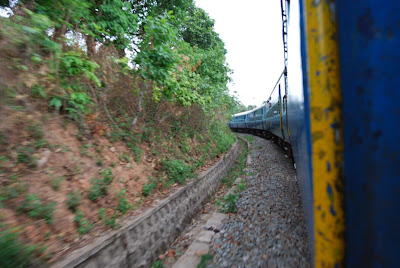
Photographer:
Nisha Jangid, Class: Std V, Government Primary School, Sheopur
Date: June 2nd, 2008 Location: Doob Kund, 60 kms away from Sheopur city
Take a two minutes to look at the picture. Exactly two minutes. 120-119-118-117-116....
....
....
...
...
...
60-59-58-57-56-55...
.....
....
....
.....
....
5-4-3-2-1-0. Okay stop now. And don't worry. We ain't inviting your thoughts this time :-((( sorry folks!!
What we want to share with you is how the thought-process of young children is shaping up when they are given a tool and a skill to express ideas.
Read the conversation between Manisha, one of the participants and Nisha who shot the picture at Doob Kund and you will figure out what we are talking about.
Nisha: "Wow! This place is picturesque. I'll go for a wide angle shot."
Manisha: "I bet you should stand right there. And don't zoom in. Just take a long shot."
Nisha [looks through the viewfinder]: "Oh! There's no headspace. Not all pillars are in the frame. I'll step back."
Takes few steps back .... but something catches her attention and she instantly changes her subject of focus.
Manisha: "What are you shooting? That looks like a broken piece of a wall or may be a pillar. Yeah. That's what it is."
Unperturbed, Nisha is busy arranging her frame (both camera's and her mind)
 Manisha
Manisha: "What on earth are you shooting????!!!!"
Nisha's camera answered: Click-Click-Click.
Manisha: "????!!! Whhhhaaatttt?"
Nisha's camera again: More clicks. Vertical. Horizontal. And some more clicks.
Manisha: "???????????????!!!!!!!!!!!!!!!??????????Eeeehhhh!!!"
A little later, Nisha turned to explain: "Don't you think it's a wonderful design? It'll make for a good picture. And guess what? I have a great idea."
Manisha, who's furious: "To replicate the design on your clothes?"
Nisha: "No."
Manisha: "Get an imprint on your hand then???? Ridiculous."
Nisha: "Heck no!!"
Manisha: "Then whhhaaaat is it?"
Nisha: "It can make for a beautiful manhole cover."
Manisha: "????? Of all the things, a manhole cover? Are you crazy?????"
Nisha: "You are dumb. Just think of it. What we don't have right now are lids covering manholes. And that's why all the filth and garbage flows on to the roads and into the streets. When you have a nice design engraved on the lid, people might as well start using it. It'll control overflowing sewage."
Some noble thought, this!!!
Our blogger intelligence bureau reports: Every manhole cover in Japan is engraved with designs that each town and city is famous for. For instance, Osaka, which is a port city, has lids with Osaka castle or designs depicting a boat and the like engraved on manhole covers. It's a common sight in Japan and perhaps this is one of the reasons why the country has clean and neat roads.
 Manhole cover in Japan. Source: Sewage Works Association, Tokyo
Manhole cover in Japan. Source: Sewage Works Association, Tokyo
Our verdict: Nisha, hailing from a remote village in Sheopur district, is blissfully unaware of this fact. But we are glad that
Freedom of Expression as an initiative is surely firing up imagination of participants and is equipping them with a skill to make the world a better place to live.
And that's the way to go....












































